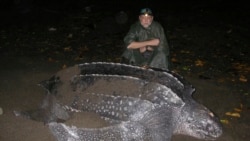Scientists say there has been a major drop in the population of leatherback sea turtles off the U.S. West Coast.
Researchers say there was an 80 percent drop in one group of leatherbacks found off the California coast over the past 30 years. One recent study found a 5.6 percent yearly decrease in the population.
Leatherbacks are massive sea turtles dating back to the time of the dinosaurs. The animals can grow up to 1.5 meters in length and weigh as much as 680 kilograms.
The leatherback sea turtles found along the U.S. Pacific coast are actually born thousands of kilometers away, on beaches in Indonesia, Papua New Guinea, Vanuatu and the Solomon Islands. The animals migrate 11,000 kilometers across the Pacific Ocean to feed on jellyfish in waters off the U.S. West Coast. Then, they swim back.
As many as 60 percent of the leatherback turtles born in the western Pacific Ocean are believed to make the trip to California. Scientists are not sure why some do and others do not. Some go farther north, to waters off Oregon or Washington state.
Scott Benson is an ecologist with the U.S. National Oceanic and Atmospheric Administration's (NOAA) fisheries service in Monterey, California. He has studied the turtles for many years and recently co-wrote a study on leatherback populations. Benson told The Associated Press that the long trip across the Pacific demonstrates the strength of the sea turtles.
“There are birds that go farther, but they fly. There's a whale shark that might swim a little further, but it doesn't have to come up for air,” he said. The leatherbacks, he noted, are “actually pushing water all the way across the Pacific Ocean.”
Now, just as scientists are beginning to fully understand these unusual creatures, the turtles are quickly disappearing. Similar population decreases have also been documented at beaches where leatherbacks nest on the western Pacific.
Scientists say that if nothing changes, the leatherbacks could completely disappear from the U.S. West Coast within 30 years. The population drops are mainly blamed on international fishing activities, the destruction of nesting grounds and climate change.
“The turtles were there and we finally started paying attention,” said Jim Harvey, director of San Jose State University's Moss Landing Marine Laboratories. He was a co-writer of the new study. “We got into looking at the story just as the story was ending,” Harvey told the AP.
The study provides important information, but also shows the threats the leatherbacks face, said Daniel Pauly, a fisheries professor at the University of British Columbia in Canada. Pauly, who was not involved in the study, is an international expert on the effects of fishing on ocean ecosystems.
The animals can be killed when they get trapped in fishing equipment. Scientists say the population is also harmed because a lot of turtle eggs are removed from beaches.
Researchers say that while all the world's leatherbacks are under pressure, the group that migrates for months across the Pacific faces the greatest threats.
“If you find the decline in one place, that might have a number of causes, but if you find the same estimate of decline in two places that is something much more serious,” Pauly said. He added that the sea turtles “are really in big trouble.”
NOAA launched an aggressive plan to save leatherbacks in 2015 and is set to release a new action plan this month. The plan is meant to persuade governments and international organizations to join efforts to save the turtles.
Benson, the NOAA ecologist, said there is still time to stop the decrease, but that it will require an immediate, international effort. “If nothing is done to reverse this course, this population will become … extinct in the Pacific Ocean."
I’m Bryan Lynn.
The Associated Press reported on this story. Bryan Lynn adapted the report for Learning English. Hai Do was the editor.
_____________________________________________
Words in This Story
nest – v. to live in a nest (a home built by animals where they can lay eggs and live)
ecosystem – n. everything that exists in a particular environment
decline – n. a situation in which something becomes less in amount, importance, quality or strength
reverse – v. to change a situation or the order of things so that it becomes the opposite
extinct – adj. when something (such as a plant or animal species) has died out completely











